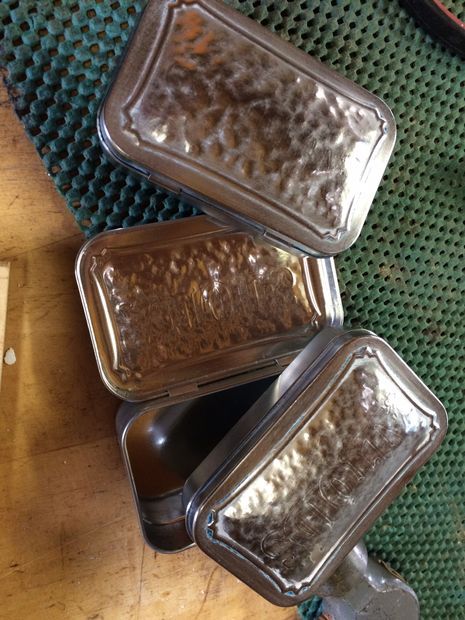Black Hand
Cannon
- Joined
- Mar 17, 2005
- Messages
- 9,348
- Reaction score
- 897
If you drink enough of the Rum, you won't care how the fruitcake tastes. Seems a waste of perfectly good Rum to use it as mood-lighting...2. Set fire to the rum.

If you drink enough of the Rum, you won't care how the fruitcake tastes. Seems a waste of perfectly good Rum to use it as mood-lighting...2. Set fire to the rum.
I did thanks!Sicilian Longhunter:
Sorry for the delay in reply.... I just looked back at this thread. I assume you found pics of Ted's stuff.…..
Carbon,The hammer marks camouflage the lettering. Use a small (ballpeen hammer use the round end)
Place the lid on the cut end of a block of firewood or on an anvil. Start in the middle hammering, slowly working away from the center, and slightly raising the lid up on one side or the other to shape the dome. you hammer on the underside of the lid and the topside is face down.
Check the lid fit often for deformation or warping. The whole process takes a few minutes.
The process works great on Altoids mini tins.
Note: you can buy Altoids size tins without any lettering.
View attachment 2020

The small tin that some on this forum have in their shooting bags look like altoids mint boxes. I hope I am correct. I have a dozen of them I use for lots of little things.
Yes - not PC, but certainly better than many other options (which have included plastic containers and zip-top bags).They’re not PC.
Ted Cash sells retro brass tinder boxes based on period originals that fulfill the same duties and are much closer to what they would have used. But many here could care less about historical accuracy.
Yes - not PC, but certainly better than many other options (which have included plastic containers and zip-top bags).
As to the TC tinder boxes - Can you say for certain they were used for patches in the period or are you going along with the modern usage? Tinder boxes were used for fire-starting supplies and I have yet to see one from the period containing patches. As a matter of fact, I don't believe I've ever seen a period container used for patching. Can anyone enlighten us with period items?
Not ideal, but a step in the correct direction. This is one of those small details that adds to a portrayal. I have a copper box I made to hold period cards that will eventually be converted to a tin for patches. That said, I still have little idea what was actually used to hold pre-lubed patching. Until then, a lidded, hinged metal tin will need to suffice.No but I sure as hell can’t imagine Altoid containers being used instead!!
Not ideal, but a step in the correct direction. This is one of those small details that adds to a portrayal. I have a copper box I made to hold period cards that will eventually be converted to a tin for patches. That said, I still have little idea what was actually used to hold pre-lubed patching. Until then, a lidded, hinged metal tin will need to suffice.
No one is arguing this point. The only point I am trying to make is the tins are a better choice than plastic bags/containers....they sure were NOT using japaned Altoids tins!!
If you drink enough of the Rum, you won't care how the fruitcake tastes. Seems a waste of perfectly good Rum to use it as mood-lighting...
I'd rather drink Rum in the dark than burn it for illumination. I find its internal effects illuminating enough....
Not for mood-lighting, but as way to illuminate the table to save candles, plus to able to get a better visual effect when enjoying an apple or other fruit pie.
Yes - tinderboxes, snuff boxes and "tin" containers (plain, painted or Japanned) are known and could have been used.
Thanks Spence!The Pennsylvania Gazette
September 18, 1755
Just imported in the ship Beulah, John Ritchie master, from London, and to be sold by CHARLES COXE,…. brass mounted hangers, with red leather belts, sleeve buttons, metal spectacles and horn jointed ditto, japanned metal snuff boxes, iron tobacco boxes,...
Spence
Thanks for the info.Japan finish is a black varnish or lacquer commonly used in the 18th c to protect iron & tinned surfaces from rust. A "japanned metal snuff box" likely refers to an inexpensive small (pocket size) tin box to hold snuff (powdered tobacco) to be inhaled.